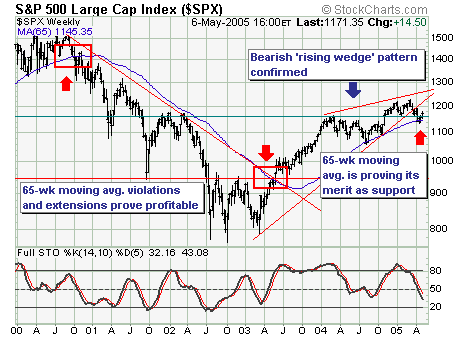After its big drop in mid-April, the Dow has rallied back to a classic resistance level now: 10400. Just look at the chart:
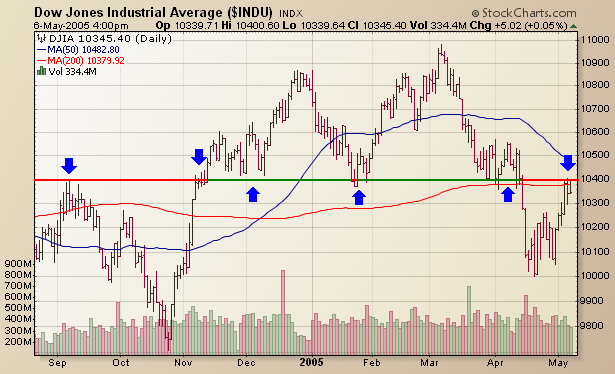
This is one of those "support-becomes-resistance" levels that has had a big impact on the market in the past (blue arrows) and will probably continue to influence the market's thinking for some time to come.
But enough about that, let's see what our other commentators are thinking these days...
.
Every time I write about a certain stock market index, I'm asked why I don't write about some of the others. I generally try to spread my coverage around to all the major stock indexes, but can't cover them all at once. I also try to find the one that's giving the truest read on the overall market. Yesterday, for example, I used the S&P 500 for an in-depth market view and came up with a mixed picture. If I had chosen the Nasdaq, I would have a gotten more negative reading. If I had chosen the NYSE Composite Index , I would have come up with a slightly more positive read. Chart 1 shows part of the reason why. The NYSE is the only one of the major market indexes that stayed over its 200-day moving average in late April. Considering that most of those indexes are now back above their 200-day lines, I'd have to say that the NYSE may have given the most reliable reading. I decided to focus on the NYSE today and to re-introduce some point & figure charts. I'm going to revisit the Bullish Percent Indexes on the major market averages which also utilize point and figure charts.
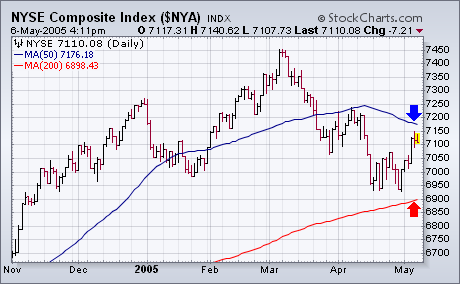
The S&P 500 can do it, but the Nasdaq and the Small-caps can't do it. Or at least not just yet. Led by Finance, the S&P 500 broke above its late April high and resistance at 1165. However, the Nasdaq and S&P SmallCap Index stalled at corresponding resistance levels. This amounts to a non-confirmation. The generals (large-caps) are charging ahead, but the troops (small-caps and technology) are getting cold feet. It is hard to be fully bullish with these indices lagging.
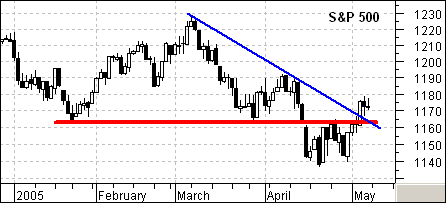

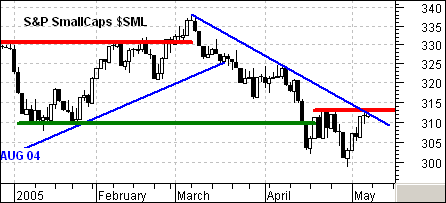
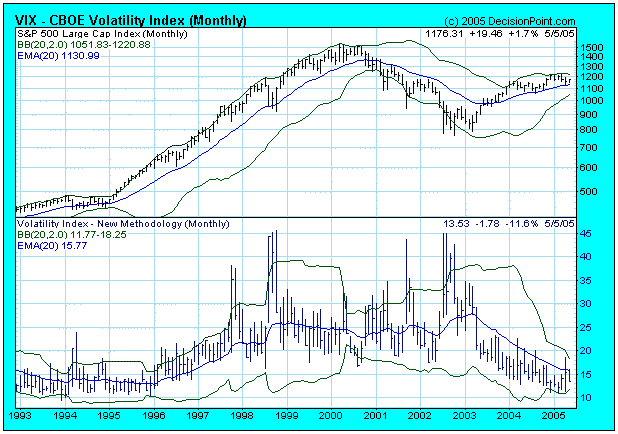
The CBOE Volatility Index (VIX) is a measure of the implied volatility of SPX index options. (According to the CBOE web site, "volatility is a measure of the fluctuation in the market price of the underlying security.") As a practical matter, the VIX measures the amount of fear that options writers have about the future volatility of the market, and, as with any sentiment gage, it is based upon current market action.
While the VIX is most commonly used for short-term analysis, it is also useful to interpret it in a longer-term historical context. I have done this before, but an interview with Larry McMillan in the May 2005 issue of Active Trader magazine prompted me to revisit the topic.
One of he arguments being used to support a bearish case for the market is that the VIX readings have been very low, but as you can see, this is not always the case. While low VIX readings may reflect complacency, they do not necessarily mean that the market is going to decline. For example, an extended period of low volatility preceded the 1995-2000 bull market up leg.
John Bollinger has made the point that low volatility usually precedes a period of high volatility, much like the calm before a storm, but it does not predict if the coming period of high volatility will be associated with price advance or price decline.
Conversely, while we can clearly see that there are high spikes on the VIX at the bottom of market corrections, higher VIX readings are also possible during market advances.
The bottom line is that you should look at historical charts to verify bullish or bearish assertions based upon a particular indicator. There may be an extended market decline in our immediate future, but the currently low VIX reading does not provide any proof to the argument.
From a structural and fundamental point-of-view, things are bearish right now; however, the technical and sentiment action surrounding recent price gains is quite constructive; thus a larger rally appears underway. We are bullish but only insofar as the 65-week moving average of the S&P 500 holds at the 1145 level on a closing basis. If the 1164 level is broached, then this will be the first sign a larger breakdown is underway, and hence will put us into an initial short position; with a break of 1145 consider an 'all out bear market' calling for an overweight short position.
This is our simple roadmap stay long until our 'pivot points' are hit, and then act with impunity. For once the 65-week moving average is violatedthen the decline should be swift and heart wrenching.
